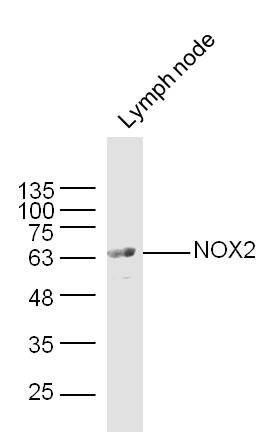NOX2 Rabbit pAb
NOX2 Rabbit pAb
- 产品详情
- 实验流程
- 背景知识
Application
| WB, IHC-P, IHC-F, IF |
|---|---|
| Primary Accession | P04839 |
| Reactivity | Human, Mouse, Rat |
| Predicted | Chicken, Dog, Pig, Horse, Rabbit |
| Host | Rabbit |
| Clonality | Polyclonal |
| Calculated MW | 65336 Da |
| Physical State | Liquid |
| Immunogen | KLH conjugated synthetic peptide derived from human NOX2 |
| Epitope Specificity | 501-570/570 |
| Isotype | IgG |
| Purity | affinity purified by Protein A |
| Buffer | 0.01M TBS (pH7.4) with 1% BSA, 0.02% Proclin300 and 50% Glycerol. |
| SUBCELLULAR LOCATION | Membrane. |
| SIMILARITY | Contains 1 FAD-binding FR-type domain. Contains 1 ferric oxidoreductase domain. |
| Post-translational modifications | Glycosylated. |
| DISEASE | Defects in CYBB are a cause of chronic granulomatous disease X-linked (XCGD) [MIM:306400]. Chronic granulomatous disease is a genetically heterogeneous disorder characterized by the inability of neutrophils and phagocytes to kill microbes that they have ingested. Patients suffer from life-threatening bacterial/fungal infections. |
| Important Note | This product as supplied is intended for research use only, not for use in human, therapeutic or diagnostic applications. |
| Background Descriptions | NOX2/gp91phox is a critical component of the membrane-bound oxidase of phagocytes that generates superoxide. It is the terminal component of a respiratory chain that transfers single electrons from cytoplasmic NADPH across the plasma membrane to molecular oxygen on the exterior. It also functions as a voltage-gated proton channel that mediates the H(+) currents of resting phagocytes. It participates in the regulation of cellular pH and is blocked by zinc. Defects in CYBB are a cause of X-linked chronic granulomatous disease (X-CGD). X-CGD is characterized by the failure of activated phagocytes to generate superoxide. Patients suffer from life-threatening bacterial/fungal infections. |
| Gene ID | 1536 |
|---|---|
| Other Names | NADPH oxidase 2, 1.6.3.-, CGD91-phox, Cytochrome b(558) subunit beta, Cytochrome b558 subunit beta, Cytochrome b-245 heavy chain, Heme-binding membrane glycoprotein gp91phox, Neutrophil cytochrome b 91 kDa polypeptide, Superoxide-generating NADPH oxidase heavy chain subunit, gp91-1, gp91-phox, p22 phagocyte B-cytochrome, CYBB (HGNC:2578), NOX2 |
| Dilution | WB=1:500-2000,IHC-P=1:100-500,IHC-F=1:100-500,IF=1:100-500 |
| Storage | Store at -20 °C for one year. Avoid repeated freeze/thaw cycles. When reconstituted in sterile pH 7.4 0.01M PBS or diluent of antibody the antibody is stable for at least two weeks at 2-4 °C. |
| Name | CYBB (HGNC:2578) |
|---|---|
| Synonyms | NOX2 |
| Function | Catalytic subunit of the phagocyte NADPH oxidase complex that mediates the transfer of electrons from cytosolic NADPH to O2 to produce the superoxide anion (O2(-)) (PubMed:15338276, PubMed:36241643, PubMed:36413210, PubMed:38355798). In the activated complex, electrons are first transferred from NADPH to flavin adenine dinucleotide (FAD) and subsequently transferred via two heme molecules to molecular oxygen, producing superoxide through an outer-sphere reaction (Probable) (PubMed:38355798). Activation of the NADPH oxidase complex is initiated by the assembly of cytosolic subunits of the NADPH oxidase complex with the core NADPH oxidase complex to form a complex at the plasma membrane or phagosomal membrane (PubMed:19028840, PubMed:38355798). This activation process is initiated by phosphorylation dependent binding of the cytosolic NCF1/p47-phox subunit to the C-terminus of CYBA/p22-phox (By similarity). NADPH oxidase complex assembly is impaired through interaction with NRROS (By similarity). |
| Cellular Location | Cell membrane; Multi-pass membrane protein. Note=As unassembled monomer may localize to the endoplasmic reticulum |
| Tissue Location | Detected in neutrophils (at protein level). |
For Research Use Only. Not For Use In Diagnostic Procedures.
Provided below are standard protocols that you may find useful for product applications.
BACKGROUND
NOX2/gp91phox is a critical component of the membrane-bound oxidase of phagocytes that generates superoxide. It is the terminal component of a respiratory chain that transfers single electrons from cytoplasmic NADPH across the plasma membrane to molecular oxygen on the exterior. It also functions as a voltage-gated proton channel that mediates the H(+) currents of resting phagocytes. It participates in the regulation of cellular pH and is blocked by zinc. Defects in CYBB are a cause of X-linked chronic granulomatous disease (X-CGD). X-CGD is characterized by the failure of activated phagocytes to generate superoxide. Patients suffer from life-threatening bacterial/fungal infections.
REFERENCES
Royer-Pokora B.,et al.Nature 322:32-38(1986).
Jirapongsananuruk O.,et al.Clin. Immunol. 104:73-76(2002).
Ota T.,et al.Nat. Genet. 36:40-45(2004).
Mural R.J.,et al.Submitted (SEP-2005) to the EMBL/GenBank/DDBJ databases.
Dinauer M.C.,et al.Nature 327:717-720(1987).
终于等到您。ABCEPTA(百远生物)抗体产品。
点击下方“我要评价 ”按钮提交您的反馈信息,您的反馈和评价是我们最宝贵的财富之一,
我们将在1-3个工作日内处理您的反馈信息。
如有疑问,联系:0512-88856768 tech-china@abcepta.com.























 癌症的基本特征包括细胞增殖、血管生成、迁移、凋亡逃避机制和细胞永生等。找到癌症发生过程中这些通路的关键标记物和对应的抗体用于检测至关重要。
癌症的基本特征包括细胞增殖、血管生成、迁移、凋亡逃避机制和细胞永生等。找到癌症发生过程中这些通路的关键标记物和对应的抗体用于检测至关重要。 为您推荐一个泛素化位点预测神器——泛素化分析工具,可以为您的蛋白的泛素化位点作出预测和评分。
为您推荐一个泛素化位点预测神器——泛素化分析工具,可以为您的蛋白的泛素化位点作出预测和评分。 细胞自噬受体图形绘图工具为你的蛋白的细胞受体结合位点作出预测和评分,识别结合到自噬通路中的蛋白是非常重要的,便于让我们理解自噬在正常生理、病理过程中的作用,如发育、细胞分化、神经退化性疾病、压力条件下、感染和癌症。
细胞自噬受体图形绘图工具为你的蛋白的细胞受体结合位点作出预测和评分,识别结合到自噬通路中的蛋白是非常重要的,便于让我们理解自噬在正常生理、病理过程中的作用,如发育、细胞分化、神经退化性疾病、压力条件下、感染和癌症。







